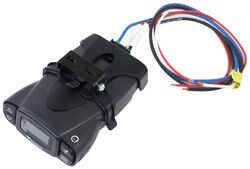
Checking Electric Trailer Brake Magnets for Wear, Shorts, Amperage, and Resistance
Question:
PLEASE HELP. 2010 Tundra 800 miles and 2003 30 foot trailer. I am leaving in a few days to travel through the mountains with my RV trailer. I am very concerned about the safety of my family. I have a P3 controller. I noticed a serious problem when I used my manual lever to adjust the watts. When I use the manual lever all the way over and the trailer and truck are at the end of braking just befor stopping, I get the overload message. I have check the ohms at the pigtail and it is 1.3. I cut all 4 of the magnet wires and get 3.6 on three of them and 4.1 on the forth. Is the magnet bad if it is below or ABOVE 3.2-3.5 Ohms? Does my 4.1 have to be replaced? If the magnet does not have to be replaced, please suggest another diagnostic test I can do to find my problem. I need to fix this problem quickly. Please help, this issue is always on my mind and causing me great frustration. Thank you
asked by: Frank C
Expert Reply:
I would check the magnets for wear before going on to test them with a meter. If the magnets show abnormal wear or if you can see the windings beginning to show through the friction surface of the magnet then they will need to be replaced.
To further test your magnets, first make sure the trailer is not connected when performing this test. If the trailer is connected, you run the risk of shorting out the brake controller or various other electrical components.
To test the brake magnets with an ampmeter, connect the ammeter between the positive battery terminal of a separate battery and one of the magnet wires. Then, connect the other magnet wire to the negative battery terminal. Check the amperage, if the amperage is greater than the specified amount in the chart below, replace the magnet. If the reading is less than the specified amount, then the leads are bad and the magnet should be replaced.
Electromagnet Specifications:
7 inch Diameter Brake Drum:
Max Amps at 9-10.5 Volts
2 Brakes 4.7-5.6
4 Brakes 9.5-11
6 Brakes 14.3-16
Max Amps at 12-13 Volts
2 Brakes 6.3-6.8
4 Brakes 12.6-13.7
6 Brakes 19.0-20.6
10 and 12 Inch Brake Drums
Max Amps at 9-10.5 Volts
2 Brakes 5.6-6.6
4 Brakes 11.3-13.3
6 Brakes 17.0-20.0
Max Amps at 12-13 Volts
2 Brakes 7.5-8.2
4 Brakes 15.0-16.3
6 Brakes 22.6-24.5
Next, disconnect the negative wire from the brake magnet wire and connect it to the base, housing, of the brake magnet. If there is any amperage, the magnet is shorted and will need to be replaced.
Finally, using an ohmmeter, check the resistance between the brake magnet wires. If the resistance is not within the specified range below, the magnet will need to be replaced.
7 inch brake magnet resistance should be 3.8-4.0 Ohms
10 and 12 inch brake magnets resistance should be 3.2-3.5 Ohms
You may also want to reset the P3 brake controller, # 90195. First, connect the trailer to the tow vehicle. Then with engine running, set the power (with the Power Buttons) to indicate 6.0. Next, drive the tow vehicle and trailer on a dry, level, paved surface at 25 mph and fully apply the Manual Override.
If trailer brakes lock up, turn the power down using Power Buttons. If braking was not sufficient, turn power up. Keep making adjustments until the power has been set to a point just below wheel lock up or at a sufficient force as to achieve maximum braking power.
Using the brake pedal, make a few low speed stops to check the power setting.
You can also try adjusting the boost setting to the next highest level. This will potentially allow you to use the manual override less. I have included a link to the installation details for reference.

Products Referenced in This Question
Tekonsha Prodigy P3 Trailer Brake Controller - 1 to 4 Axles - Proportional
- Trailer Brake Controller
- Proportional Controller
- Electric
- Electric over Hydraulic
- Automatic Leveling
- Under-Dash Box
- Dash Mount
- Up to 4 Axles
- LCD Display
- Up to 360 Degrees
- Tekonsha
more information >
Product Page this Question was Asked From
Trailer Brake Magnet For Dexter 12-1/4 Brake Assembly, White Wire
- Accessories and Parts
- Trailer Brakes
- Electric Drum Brakes
- Brake Magnets
- 12-1/4 x 2-1/2 Inch
- Redline
more information >
Featured Help Information
Instructions

Continue Researching
- Shop: Bearing, 42MM Nev-R-Lube 42MM x 76MM x 39MM
- Search Results: electric brake magnet clip
- Shop: BOLT brand vehicle and hitch locks
- Q&A: 2019 F250 Super Duty Bolt Lock Compatability w/ Key Fob
- Shop: Trailer Brake Magnet For Dexter 12-1/4 Brake Assembly, White Wire
- Shop: Magnet Retainer Clip for Oval Magnet
- Q&A: What Size Socket is Needed to Remove/Install Nev-R-Lube Spindle Nut # 6-183
- Shop: BOLT Trailer Hitch Receiver Lock - 2", 2-1/2", and 3" Hitches - Ford Side-Cut Key
- Shop: 50MM Nev-R-Lube Bearing for 8,000-lb Dexters - Qty 1
- Shop: Trailer Hitch Receiver Reducer Sleeves - 3" to 2-1/2" or 2"
- Shop: Electric Trailer Brake Assembly - Self-Adjusting - 12" - Left Hand - 5,200 lbs to 7,000 lbs
- Q&A: How to Know When Trailer Brake Magnets are Worn Out and Need Replacing
- Video: Review of Dexter Replacement Left Hand Brake Shoes For 10 Inch Nev-R-Adjust Electric - K71-681
- Search Results: brake shoes
- Search Results: backup camera
- Video: Trailer Brake Controller Wire Testing
- Article: Troubleshooting Brake Controller Installations
- Shop: Brake Controller
- Article: Testing Trailer Brake Magnets for Proper Function
- Shop: Trailer Wiring
- Video: Trailer Brake Controller Installation - 2015 Ram 3500
- Article: Testing Brake Controls
- Search Results: 3024p
- Search Results: 3024~p
- Video: Tekonsha Prodigy P3 Trailer Brake Controller Review
- Video: Hopkins Custom Fit Vehicle Wiring - Fifth Wheel and Gooseneck Wiring - HM41158 Review
- Video: Choosing the Right Trailer Wiring
- Shop: Fifth Wheel Hitch
- Search Results: battery backup
- Search Results: break away trailer brake

























